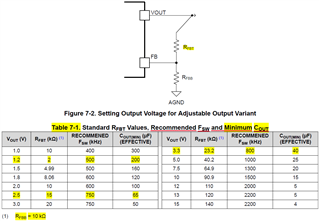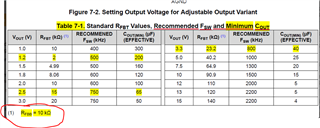Tool/software:
There're few questions here.
1. What's the reason that the equation needs to follow 5K < Rfbt//Rfbb <= 10K ?
2. In application, the Vout = 1.2V, Rfbb=10K and Rfbt=2K are suggested in table 7-1. however if 1.6K is selected for Rfbt, any side impact?
3. In the table 7-1, the 200uF is suggested to use for given Vout=1.2V and Fsw. but in reality there's a pcb size constriain. it looks 200uF is too big size. Is there related equation or curve about this Cout determine?
4. Customer would like to design as below I/O spec with TPSM33625. How to select and design the Fsw and Cout? This is for the AC inverter application.
Vin = 5V
3.3V/300mA
1.2V/200mA
1.3V/450mA
2.5V/150mA




 '
'